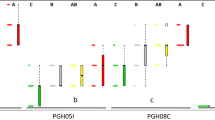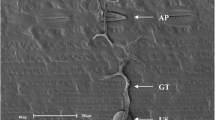Abstract
The interaction between Alternaria dauci and two carrot cultivars differing in their resistance to leaf blight was investigated by microscopy. The fungal development between 1 and 15 days post-inoculation was quite similar in the susceptible cv. Presto and the partially resistant cv. Texto: After conidial germination, leaf adhesion of the pathogen was achieved with mucilaginous filaments; hyphae penetrated the leaves directly with/without the formation of appressoria-like structures or via stomata; the fungus spread by epiphytic hyphae with hyphopodia and subcuticular mycelia. Intense necrotic plant cell reactions occurred under the fungal structures. At 21 days post-inoculation, typical features of fungal development were noted for each cultivar: growing hyphae emerged from stomata in cv. Presto, whereas conidiophores without conidia were observed in cv. Texto. Leaf tissues of both cultivars were strongly damaged and vesicle-like structures (assumed to be plant phenolics) were abundantly present between mesophyll cells. A real-time PCR method was developed for in planta quantification of A. dauci. Between 1 and 15 days post-inoculation, the fungal biomass was equivalent in the two cultivars and was about fourfold higher in cv. Presto than cv. Texto at 21 and 25 days post-inoculation. Taken together, our results indicated that A. dauci was able to colonize both cultivars in a similar manner during the first steps of the interaction, then fungal development in the partially resistant cultivar was restricted due to putative plant defence reactions. The results of this study enhance the overall understanding of infection processes in the A. dauci-carrot pathosystem.




Similar content being viewed by others
Abbreviations
- ALB:
-
Alternaria leaf blight
- Ct:
-
cycle threshold
- Dpi:
-
days post-inoculation
- ITS:
-
internal transcribed spacers
- 6-MM:
-
6-methoxymellein
- gpd:
-
glyceraldehyde-3-phosphate dehydrogenase
- qPCR:
-
quantitative PCR
- SEM:
-
scanning electron microscopy
- TEM:
-
transmission electron microscopy
References
Bennett, R. N., & Wallsgrove, R. M. (1994). Secondary metabolites in plant defence mechanisms. New Phytologist, 127, 617–633.
Ben-Noon, E., Shtienberg, D., Shelvin, E., & Dinoor, A. (2003). Joint action of disease control measures: a case study of Alternaria leaf blight of carrot. Phytopathology, 93, 1320–1328.
Ben-Noon, E., Shtienberg, D., Shelvin, E., Vintal, H., & Dinoor, A. (2001). Optimization of chemical suppression of Alternaria dauci, the causal agent of Alternaria leaf blight in carrots. Plant Disease, 85, 1149–1156.
Berto, P., Commenil, P., Belingheri, L., & Dehorter, B. (1999). Occurrence of a lipase in spores of Alternaria brassicicola with a crucial role in the infection of cauliflower leaves. FEMS Microbiology Letters, 180, 183–189.
Briard, M., Le Clerc, V., Grzebelus, D., Senalik, D., & Simon, P. W. (2000). Modified protocols for rapid genomic DNA extraction and AFLP analysis using silver stain or radioisotopes. Plant Molecular Biology Reporter, 18, 235–241.
Brouwer, M., Lievens, B., Van Hemelrijck, W., Van den Ackerveken, G., Cammue, B. P. A., & Thomma, B. P. H. J. (2003). Quantification of disease progression of several microbial pathogens on Arabidopsis thaliana using real-time fluorescence PCR. FEMS Microbiology Letters, 228, 241–248.
Dugdale, L. J., Mortimer, A. M., Isaac, S., & Collin, H. A. (2000). Disease response of carrot and carrot somaclones to Alternaria dauci. Plant Pathology, 49, 57–67.
Farrar, J. J., Pryor, B. M., & Davis, R. M. (2004). Alternaria diseases of carrot. Plant Disease, 88, 776–784.
Gao, X., Jackson, T. A., Lambert, K. N., Li, S., Hartman, G. L., & Niblack, T. L. (2004). Detection and quantification of Fusarium solani f. sp. glycines in soybean roots with real-time quantitative polymerase chain reaction. Plant Disease, 88, 1372–1380.
Gold, R. N., & Mendgen, K. (1984). Cytology of basidiospore germination, penetration, and early colonization of Phaseolus vulgaris by Uromyces appendiculatus var. appendiculatus. Canadian Journal of Botany, 62, 1989–2002.
Gugino, B. K., Carroll, J. E., Widmer, T. L., Chen, P., & Abawi, G. S. (2007). Field evaluation of carrot cultivars for susceptibility to fungal leaf blight diseases in New York. Crop Protection, 26, 709–714.
Hatzipapas, P., Kalosaka, K., Dara, A., & Christias, C. (2002). Spore germination and appressorium formation in the entomophagic Alternaria alternata. Mycological Research, 106, 1349–1359.
Howard, R. J. (1997). Breaching the outer barriers: Cuticle and cell wall penetration. In Carroll, & Tudzynski (Eds.) The Mycota: Plant relationships (pp. 43–60). Berlin: Springer.
Isshiki, A., Akimitsu, K., Yamamoto, M., & Yamamoto, H. (2001). Endopolygalacturonase is essential for Citrus Black Rot caused by Alternaria citri but not Brown Spot caused by Alternaria alternata. Molecular Plant–Microbe Interaction, 14, 749–757.
Joly, P. (1964). le genre Alternaria: recherches physiologiques, biologiques et systématiques. Paris: Paul Lechevalier.
McRoberts, N., & Lennard, J. H. K. (1996). Pathogen behaviour and plant cell reactions in interactions between Alternaria species and leaves of host and nonhost plants. Plant Pathology, 45, 742–752.
Mercado-Blanco, J., Collado-Romero, M., Parilla-Araujo, S., Rodriguez-Jurado, D., & Jomenez-Diaz, R. M. (2003). Quantitative monitoring of colonization of olive genotypes by Verticillium dahliae pathotypes with real-time polymerase chain reaction. Physiological and Molecular Plant Pathology, 63, 91–105.
Mercier, J., & Kuc, J. (1997). Elicitation of 6-methoxymellein in carrot leaves by Cercospora carotae. Journal of the Science of Food and Agriculture, 73, 60–62.
Möller, E. M., Bahnweg, G., Sandermann, H., & Geiger, H. H. (1992). A simple and efficient protocol for isolation of high molecular weight DNA from filamentous fungi, fruit bodies, and infected plant tissues. Nucleic Acids Research, 22, 6115–6116.
Nicholson, R. L., & Hammerschmidt, R. (1992). Phenolic compounds and their role in disease resistance. Annual Review of Phytopathology, 30, 369–389.
Pawelec, A., Dubourg, C., & Briard, M. (2006). Evaluation of carrot resistance to Alternaria leaf blight in controlled environments. Plant Pathology, 55, 68–72.
Prasad, P., Devi, S., & Reddy, M. N. (1990). Studies of early stages of infection of Alternaria alternata on groundnut (Arachis hypogaea L.). Journal of Basic Microbiology, 30, 349–352.
Roustaee, A., Dechamp-Guillaume, G., Gelie, B., Savy, C., Dargent, R., & Barrault, G. (2000). Ultrastructural studies of the mode of penetration by Phoma macdonaldii in sunflower seedlings. Phytopathology, 90, 915–920.
Shabana, Y. M., Baka, Z. A. M., & Abdel-Fattah, G. M. (1997). Alternaria eichhorniae, a biological control agent for waterhyacinth: Mycoherbicidal formulation and physiological and ultrastructural host responses. European Journal of Plant Patholology, 203, 99–111.
Simon, P. W., & Strandberg, J. O. (1998). Diallel analysis of resistance in carrot to Alternaria leaf blight. Journal of the American Society of Horticultural Science, 123, 412–415.
Solomon, P. S., Wilson, T. J. G., Rybak, K., Parker, K., Lowe, R. G. T., & Oliver, R. P. (2006). Structural characterisation of the interaction between Triticum aestivum and the dothideomycete pathogen Stagonospora nodorum. European Journal of Plant Pathology, 114, 275–282.
Souza, R. T., Forcelini, C. A., Reis, M. E., & Calvete, E. O. (2001). Frequency of Alternaria dauci and Cercospora carotae as causal agents of carrot leaf blights in Passo Fundo, RS. Fitopatologia Brasileira, 26, 614–618.
Tanabe, K., Park, P., Tsuge, T., Kohmoto, K., & Nishimura, S. (1995). Characterization of the mutants of Alternaria alternata Japanese pear pathotype deficient in melanin production and their pathogenicity. Annals of the Phytopathological Society of Japan, 61, 27–33.
Tewari, J. P. (1986). Subcuticular growth of Alternaria brassicae in rapeseed. Canadian Journal of Botany, 64, 1277–1281.
Thomma, B. P. H. J., Eggermont, K., Tierens, K. F. M. J., & Broekaert, W. F. (1999). Requirement of functional ethylene-insensitive 2 gene for efficient resistance of Arabidopsis to infection by Botrytis cinerea. Plant Physiology, 121, 1093–1102.
Thompson, J. D., Higgins, D. G., & Gibson, T. J. (1994). Clustal W: improving the sensitivity of progressive multiple sequence alignment through sequence weighting, position-specific gap penalties and weight matrix choice. Nucleic Acids Research, 22, 4673–4680.
Vintal, H., Ben-Noon, E., Shelvin, E., Yermiyahu, U., Shtienberg, D., & Dinoor, A. (1999). Influence of rate of soil fertilization on Alternaria leaf blight (Alternaria dauci) in carrots. Phytoparasitica, 27, 1–8.
Yao, C., & Köller, W. (1995). Diversity of cutinases from plant pathogenic fungi: different cutinases are expressed during saprophytic and pathogenic stages of Alternaria brassicicola. Physiological and Molecular Plant Pathology, 8, 122–130.
Ziadi, S., Poupard, P., Brisset, M. N., Paulin, J. P., & Simoneau, P. (2001). Characterization in apple leaves of two subclasses of PR-10 transcripts inducible by acibenzolar-S-methyl, a functional analogue of salicylic acid. Physiological and Molecular Plant Pathology, 59, 33–43.
Acknowledgements
We are grateful to Bruno Hamon (UMR PaVé), Marie Tellier and Anita Suel (UMR GenHort) for their excellent technical assistance and to David Manley for revising the English in the manuscript. We are also grateful to Nathalie Leduc (UMR Sagah) for advice in histology and Robert Filmon from the Service Commun d’Imagerie et d’Analyses Microscopiques (SCIAM, Université Angers).
Author information
Authors and Affiliations
Corresponding author
Rights and permissions
About this article
Cite this article
Boedo, C., Le Clerc, V., Briard, M. et al. Impact of carrot resistance on development of the Alternaria leaf blight pathogen (Alternaria dauci). Eur J Plant Pathol 121, 55–66 (2008). https://doi.org/10.1007/s10658-007-9241-6
Received:
Accepted:
Published:
Issue Date:
DOI: https://doi.org/10.1007/s10658-007-9241-6




